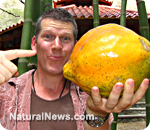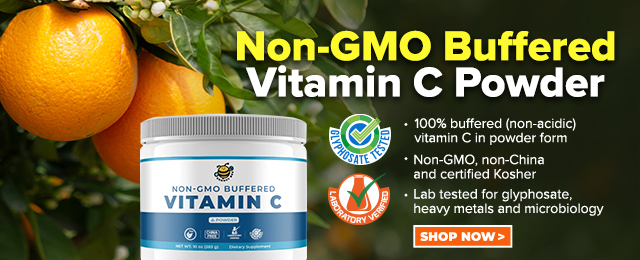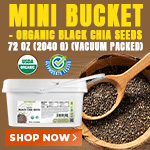
Loja and Vilcabamba, Ecuador: Destinations for health-conscious people
 Thursday, June 24, 2010 Thursday, June 24, 2010by Mike Adams, the Health Ranger Editor of NaturalNews.com (See all articles...) Tags: Vilcabamba, Ecuador, health news |
- Newly released JFK files reveal Pentagon's role in creating Lyme disease and covid in the same lab
- DEADLY DECEPTION: How COVID vaccines increased mortality rates and why authorities hid the truth
- CDC finally halts $11 billion COVID funding scam as health officials admit the ‘pandemic’ was a fraud
- The hidden dangers in your kitchen: How cooking methods impact diabetes, cancer and aging
- GAIN-OF-FUNCTION CAT-BIRD-FLU now on the rise as nearly a dozen cats in Colorado "test positive" for Bird Flu due to contaminated cat food
- Trump's greatest betrayal so far: Accelerating Middle East wars, silencing dissent, and serving Zionist masters
- Here are TEN all-natural ways to protect your garden without using harmful chemicals
- Why you should think twice before buying mainstream toothpaste formulas
- ATTENTION PRESIDENT TRUMP: Please WITHDRAW your nomination of Dr. Susan Monarez for CDC Director as she is a VAX FANATIC and TOXIC JAB ZEALOT
- Was JFK's assassination orchestrated by a CIA double agent? New evidence points to James Angleton as the “architect”
- Home gardening for preppers: A beginner's guide to growing your own food
- Ginseng's hidden anti-aging power: How compound K is rewriting the rules of skincare
- “Endgame: The Hidden Agenda 21” unveils a world of conspiracy and control
- Record honeybee deaths devastate U.S. agriculture, pesticides under scrutiny
- Paper or plastic? The environmental deception behind bag bans
- Lab leak confirmed? Boris Johnson's stunning reversal on COVID origins sparks global debate
- Speaker Johnson warns Congress may defund or disband rogue courts targeting Trump
- Senate Democrats deny censorship industrial complex existed, defend government's role in silencing dissent
- Newly released JFK files reveal Pentagon's role in creating Lyme disease and covid in the same lab
- Elon Musk: Aliens could be here on Earth RIGHT NOW
- Festive flavors: The sweet history, nutritional profile and health benefits of pecan pie
- Trump reverses course on Gaza plan, says “nobody is expelling Palestinians”
- Reclaim your health: How midlife exercise reverses years of inactivity
- Big Pharma's $8 Billion bribery scheme exposed: how doctors are pushed to prescribe junk science, not heal
- Boys are back in town: Trump’s patriotic alpha crew takes the wheel while toxic females ride in the backseat
- EPA advisor admits the agency is funneling billions to climate groups ahead of Trump’s return to White House
- Space war brewing? Russia threatens to destroy Starlink satellites
- Survival 101: Effective EMF blocking techniques
- A lack of integrity in Academia: Harvard professor found GUILTY of fraudulent research to promote CRT theory
- Mike Adams Sermon 66: God will DESTROY ISRAEL for its wickedness
- 5 Simple steps to boost your brainpower: How to strengthen executive function in a distracted world
- Rep. Nancy Mace introduces bill to ban biological males from female facilities on federal property
- Sugarcane extract superior to cholesterol-lowering drugs?
- WHO focusing more on policing speech about public health and implementing global surveillance systems
- Pilots report mysterious lights 'moving at extreme speeds' across Oregon skies
- Dr. Mike Yeadon releases 15-minute testimony - WATCH - about genocidal intent of COVID “vaccines”
- EPA advisor admits the agency is funneling billions to climate groups ahead of Trump’s return to White House
- The Health Ranger releases “Vaccine Zombie” song and music video, using AI-animated zombies for the music video
- California's social media censorship law struck down: A victory for free speech or a threat to online safety?
- Dr. Mike Yeadon releases 15-minute testimony - WATCH - about genocidal intent of COVID “vaccines”
- The pandemic as a tool for INDOCTRINATION: Understanding “The Indoctrinated Brain” by Dr. Michael Nehls
- Florida takes a stand: DeSantis proposes permanent ban on mRNA vaccine mandates
- Mike Adams releases country western hit single: Goin’ Back in Time is Comin’ Home
- Mike Adams releases music poetry sensation: A Child of God
- “Why we influenced the 2020 elections”: Facebook files reveal the coordinated effort to bury the Hunter Biden laptop story
- RFK Jr. clears key hurdle: Sen. Susan Collins backs controversial HHS nominee, signaling a new era for health policy
- Unpacking the Lies That We’ve Been Fed – new song and music video released by Mike Adams, the Health Ranger
- Mike Adams releases new song and music video: Nothing More Disgusting Than a Globalist
- Newly released JFK files reveal Pentagon's role in creating Lyme disease and covid in the same lab
- Congratulations to the FULLY UNVACCINATED as you resisted the COVID-19 PROPAGANDA MACHINE fueled by over $100 BILLION
- Michigan sheriff announces criminal investigation into 2020 election crimes, Dominion Voting Systems
- Israeli soldiers accused of even more torture and abuse in the West Bank
- Migrants are taking advantage of recent hurricanes to scam residents and loot their homes
- House Intelligence Committee calls for the ARREST and PROSECUTION of Dr. Anthony Fauci
- Red Cross issues warning to stop blood plasma donations from vaccinated people
- Scientists confirm: GENIUS brain function can be spontaneously unleashed in humans without any apparent cause
- EPA advisor admits the agency is funneling billions to climate groups ahead of Trump’s return to White House
- HYSSOP: What research reveals about the health benefits of this ancient holy herb
- Two containers with completed ballots fall out of truck in Florida
- Fully vaccinated about to see “tsunami” of illness and death, warns virologist
- Global leaders unite to clamp down on “misinformation” with UN-backed Cascais Declaration
- BREAKING: 2025 NDAA authorizes mandatory military draft of WOMEN across America… as Pentagon pursues global NUCLEAR war with both Russia and China at the same time
- Michael Yon warns of a ZIONIST TAKEOVER in Trump’s second administration
- BOMBSHELL: DNA testing kits are a SCAM to develop ethnic-specific bioweapons
- Ozempic and Wegovy weight loss drugs are injectable LIZARD VENOM PEPTIDES that may unleash a devastating wave of organ failure… side effects align with symptoms of SNAKE BITES
- Israeli soldiers accused of even more torture and abuse in the West Bank
- These 13 countries just signed an agreement to engineer a global FAMINE by destroying food supply
- NASA admits that climate change occurs because of changes in Earth’s solar orbit, and NOT because of SUVs and fossil fuels
- RFK Jr. clears key hurdle: Sen. Susan Collins backs controversial HHS nominee, signaling a new era for health policy
- Sermon 30: How Jesus reveals Caesar’s FAKE CURRENCY and FALSE AUTHORITY
- Coriander seeds: Ancient medicine backed by modern science
- Arizona officials claim Maricopa County needs 10-13 days to tabulate results of the election
In Loja, you'll want to stop at the health food store called Alivinatu. Located just half a block East of the Southeast corner of the Loja town square, Alivinatu offers fresh juices, soy burgers for lunch, nutritional supplements, herbal medicines, vitamins and even a health spa on the second floor.
It's not quite a Whole Foods, but it's the closest thing you'll find in Loja. The owners and staff are friendly, too. Prices are a bit on the steep side for Ecuador, but they aren't terrible.
Just 1-2 blocks down the street to the East of Alivinatu, you'll find another juice store with much better pricing (and no crowds). I don't recall the name, but it's on the same side of the street as Alivinatu and has a large yellow sign with a sun symbol on it. They offer fresh fruit juices, carrot juice and other medicinal juices. Service is frustratingly slow, even when it's not busy, but the owners are friendly and you can chat with them while they're working on your order.
Looking for fresh fruit and nuts? You'll want to visit the Frutaria on 18 de Noviembre. No, that's not a date, it's a street name. Ecuadorians often name their streets after famous holidays. I don't know what happened on the 18th of November, but it was a significant date in Ecuador's history.
In any case, if you head South from the main town square on 18 de Noviembre, you'll pass a street market area on your right. A few blocks later (to the South), you'll reach the furniture district. On the left side of the street, look for a small green awning and the word "Frutaria." Inside, you'll find a tiny shop that's jam packed with fresh fruits and nuts. The owner is talkative, and once he realizes you're actually spending some money there, he'll treat you to all sorts of free samples. Here are some of the amazing items you can find in this store:
• Organically grown hydroponic tomatoes from a local grower in Loja.
• Pitahaya cactus fruit grown on the owner's own farm in Vilcabamba.
• Almonds, macadamia nuts and pistachios.
• Pineapples, papayas, babaco fruits, mangos and berries.
• Flax seeds, flour, corn meal and other staples.
• Dried figs, dates and other fruits.
It's a wonderful shop with an impressive variety of foods considering how small it is. Service isn't speedy, but the selection is fantastic, and visiting this shop gives you a chance to practice more Spanish, too.
The local grocery store
Continuing South on 18 de Noviembre, you'll shortly arrive at Super Maxi on your left. This is the main grocery store for the town. While it's not a health food store, there are nonetheless many items you can find there that are quite healthy.In the fresh produce section, of course, you can find everything from cactus fruit to blackberries. They usually have a good selection of avocados, citrus fruit and vegetables. You'll pay a lot for apples (because they're imported from Chile), and you can find avocados at half the price in Vilcabamba, but if you want the convenience of everything in one place, check out Super Maxi.
Near the cereal section, you can also find quinoa flakes. In the peanut butter section, check out the local, Ecuadorian-made peanut butter. It's non-hydrogenated.
Raw, local honey
In Malecatos, the town just North of Vilcabamba, you can find raw local honey! It's not easy, though: You have to ask around. Just ask for "miel de abejas" which means "honey of bees." People can point you in the right direction. Eventually, you'll end up at a house where a guy is selling small plastic containers of honey out of his living room. I paid something around $3.50 per pint container, I believe. It seemed like a reasonable price, but prices always vary depending on how good your Spanish is.Healthy food in Vilcabamba
Virtually every restaurant around Vilcabamba serves fresh, raw fruit juices. You can also get Tomate de Arbol, which is a "tree tomato" fruit that's actually not a tomato, but it sort of tastes like one. (I like this juice a lot.)There are several good restaurants around town, too. Sambuca Cafe is right on the town square, and you can get some good salads there. Papaya's Cafe, owned by an American, is a great destination for healthy food in a really fun atmosphere (nice decorations, too!). The La Roca restaurant, located two blocks North of the town square (next to the police station) is owned by an Ecuadorian family from Cuenca. They offer a nice Sunday brunch, and at times they have live music on Friday or Saturday nights.
Just one block to the East of the main square, you'll find a vegetarian restaurant, and a few miles South of town, you can enjoy the kitchen of the Hosteria Izhcayluma. On the other side of town, the North side on the way to Loja, you can find Madre Tierra which has a nice kitchen, too. In that same direction, you'll also find the Hosteria Vilcabamba which offers a very nice fruit plate and some fresh juices.
Sunday markets
And then, of course, you always have the Sunday markets, both in Vilcabamba and Malecatos. In these markets, you can often buy a huge quantity of fresh fruits like mangos, papaya, oranges, etc. My friend Matt likes to buy 40 - 50 mangoes, then he takes them home, dices them and freezes the chunks for use in smoothies.You can also find fresh coconuts from time to time, depending on what's available. Ask around for fresh cocos and you might get lucky.
Now, all the fresh produce available at the Sunday markets is not necessarily organic (even if they tell you it is). Pesticides are used in Ecuador, and some local farmers in the Valley of Longevity are definitely using pesticides. So you have to be careful about your sources. Or better yet, grow your own...
Growing your own
The best way to get healthy food in the Valley of Longevity is to grow your own. That's what I've been doing for most of the past two years, and the food production capability of the region is downright legendary. I'm convinced it is among the very most land on the planet for producing large quantities of food year-round.The really amazing thing about growing food in Vilcabamba is that you can plant garden veggies any day of the year. So you can grow and harvest carrots, celery, cucumbers, tomatoes and other similar plants every single day of the year. There are no cold seasons: It's Spring-like weather year round!
There are a few properties for sale right now in the deep topsoil area of the Hacienda San Joaquin, located just outside the town of Vilcabamba. One piece of land is 2.5 acres selling for five figures. Another piece is 20 acres selling for mid six figures (it has a house, a working well, massive gardens and a young orchard). A third piece is smaller but is a world-class estate with tennis courts, indoor pool, a 5,000 square foot house and more. It's selling in the low seven figures.
If you're interested in any of these, email us at vilcaland@gmail.com and let us know what interests you. We'll forward your email to the correct party where you can see photos and a full description of various properties that might interest you. You can see some pictures of my own food production property here: https://www.naturalnews.com/Valley-of-Longevi...
Growing your own food in Ecuador is ridiculously easy, and we used neem oil, tobacco juice and pepper juice as our organic pesticides. They worked great! The irrigation water is FREE (since it comes from your own well), and labor is extremely affordable, too. If you do visit Vilcabamba, be sure to check out the properties that are available -- and be sure to check the soils at each property, because soil quality varies widely throughout the valley. Some areas are mostly rocks, other are deep top soil. So you have to check before you buy.
Again, contact us at vilcaland@gmail.com if you're interested in food production land there.
Enjoy Loja, Vilcabamba and the Valley of Longevity!
Vilcabamba at FETCH.news
Get independent news alerts on natural cures, food lab tests, cannabis medicine, science, robotics, drones, privacy and more.
 About the author:Mike Adams (aka the "Health Ranger") is a best selling author (#1 best selling science book on Amazon.com) and a globally recognized scientific researcher in clean foods. He serves as the founding editor of NaturalNews.com and the lab science director of an internationally accredited (ISO 17025) analytical laboratory known as CWC Labs. There, he was awarded a Certificate of Excellence for achieving extremely high accuracy in the analysis of toxic elements in unknown water samples using ICP-MS instrumentation. Adams is also highly proficient in running liquid chromatography, ion chromatography and mass spectrometry time-of-flight analytical instrumentation.
About the author:Mike Adams (aka the "Health Ranger") is a best selling author (#1 best selling science book on Amazon.com) and a globally recognized scientific researcher in clean foods. He serves as the founding editor of NaturalNews.com and the lab science director of an internationally accredited (ISO 17025) analytical laboratory known as CWC Labs. There, he was awarded a Certificate of Excellence for achieving extremely high accuracy in the analysis of toxic elements in unknown water samples using ICP-MS instrumentation. Adams is also highly proficient in running liquid chromatography, ion chromatography and mass spectrometry time-of-flight analytical instrumentation.
Adams is a person of color whose ancestors include Africans and Native American Indians. He's also of Native American heritage, which he credits as inspiring his "Health Ranger" passion for protecting life and nature against the destruction caused by chemicals, heavy metals and other forms of pollution.
Adams is the founder and publisher of the open source science journal Natural Science Journal, the author of numerous peer-reviewed science papers published by the journal, and the author of the world's first book that published ICP-MS heavy metals analysis results for foods, dietary supplements, pet food, spices and fast food. The book is entitled Food Forensics and is published by BenBella Books.
In his laboratory research, Adams has made numerous food safety breakthroughs such as revealing rice protein products imported from Asia to be contaminated with toxic heavy metals like lead, cadmium and tungsten. Adams was the first food science researcher to document high levels of tungsten in superfoods. He also discovered over 11 ppm lead in imported mangosteen powder, and led an industry-wide voluntary agreement to limit heavy metals in rice protein products.
In addition to his lab work, Adams is also the (non-paid) executive director of the non-profit Consumer Wellness Center (CWC), an organization that redirects 100% of its donations receipts to grant programs that teach children and women how to grow their own food or vastly improve their nutrition. Through the non-profit CWC, Adams also launched Nutrition Rescue, a program that donates essential vitamins to people in need. Click here to see some of the CWC success stories.
With a background in science and software technology, Adams is the original founder of the email newsletter technology company known as Arial Software. Using his technical experience combined with his love for natural health, Adams developed and deployed the content management system currently driving NaturalNews.com. He also engineered the high-level statistical algorithms that power SCIENCE.naturalnews.com, a massive research resource featuring over 10 million scientific studies.
Adams is well known for his incredibly popular consumer activism video blowing the lid on fake blueberries used throughout the food supply. He has also exposed "strange fibers" found in Chicken McNuggets, fake academic credentials of so-called health "gurus," dangerous "detox" products imported as battery acid and sold for oral consumption, fake acai berry scams, the California raw milk raids, the vaccine research fraud revealed by industry whistleblowers and many other topics.
Adams has also helped defend the rights of home gardeners and protect the medical freedom rights of parents. Adams is widely recognized to have made a remarkable global impact on issues like GMOs, vaccines, nutrition therapies, human consciousness.
In addition to his activism, Adams is an accomplished musician who has released over a dozen popular songs covering a variety of activism topics.
Click here to read a more detailed bio on Mike Adams, the Health Ranger, at HealthRanger.com.
Take Action: Support Natural News by linking to this article from your website
Permalink to this article:
Embed article link: (copy HTML code below):
Reprinting this article:
Non-commercial use OK, cite NaturalNews.com with clickable link.
Follow Natural News on Facebook, Twitter, Google Plus, and Pinterest
Science News & Studies
Medicine News and Information
Food News & Studies
Health News & Studies
Herbs News & Information
Pollution News & Studies
Cancer News & Studies
Climate News & Studies
Survival News & Information
Gear News & Information
News covering technology, stocks, hackers, and more



"Big Tech and mainstream media are constantly trying to silence the independent voices that dare to bring you the truth about toxic food ingredients, dangerous medications and the failed, fraudulent science of the profit-driven medical establishment.
Email is one of the best ways to make sure you stay informed, without the censorship of the tech giants (Google, Apple, Facebook, Twitter, YouTube, etc.). Stay informed and you'll even likely learn information that may help save your own life."
–The Health Ranger, Mike Adams













































